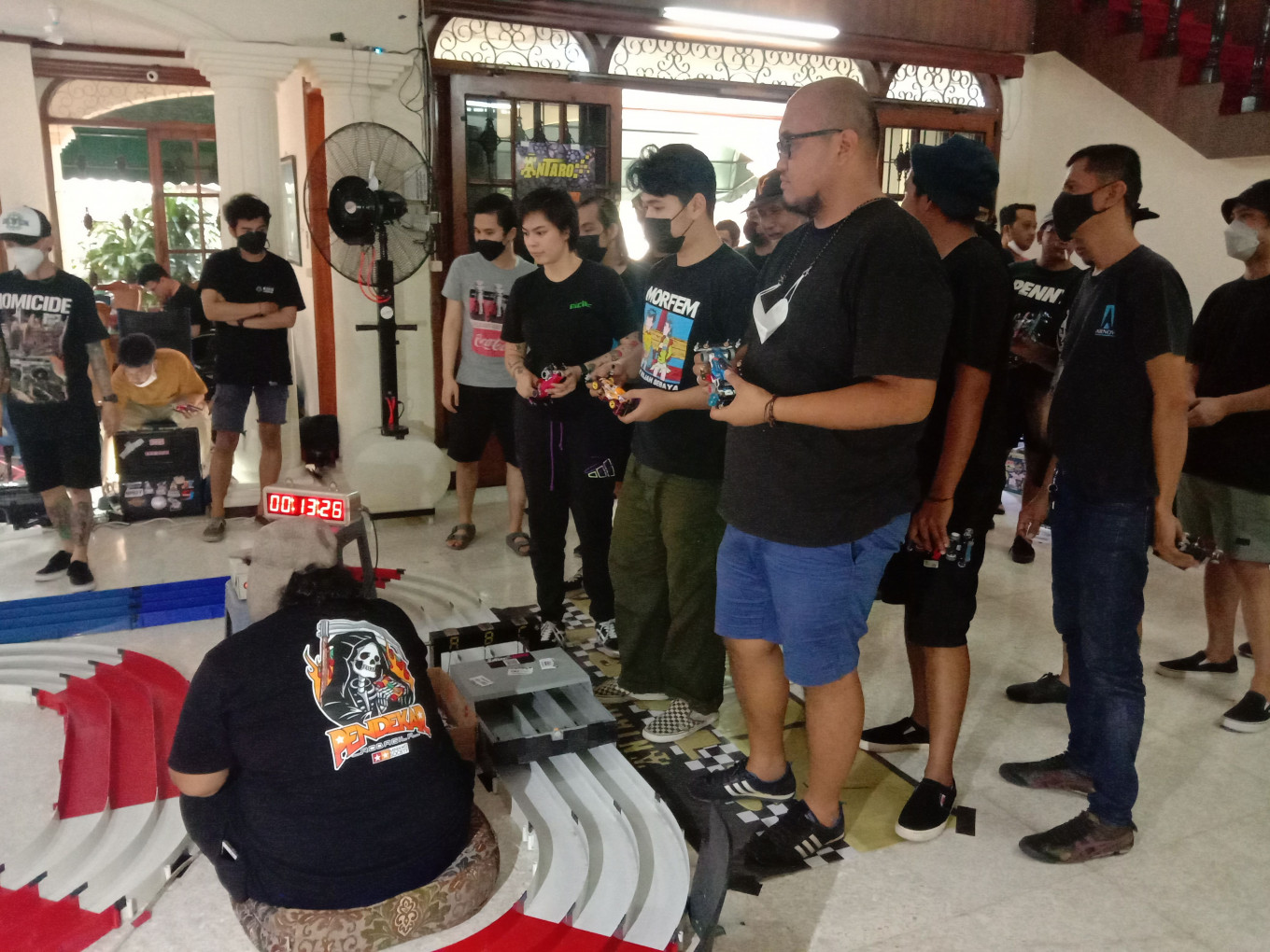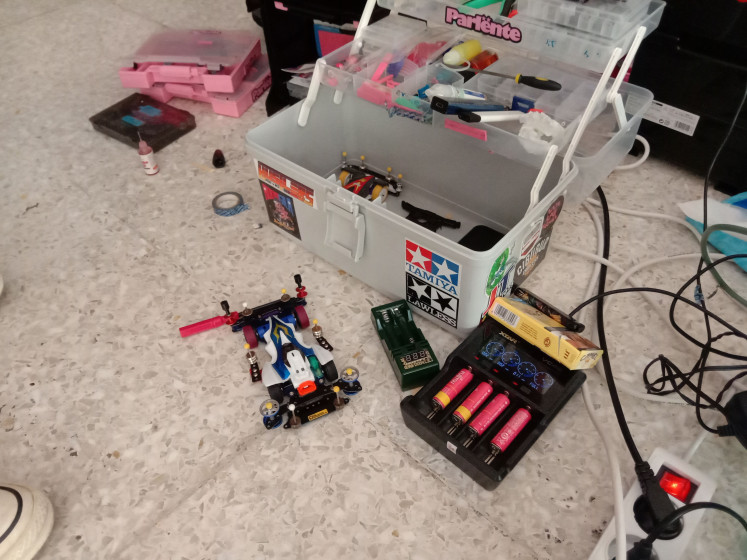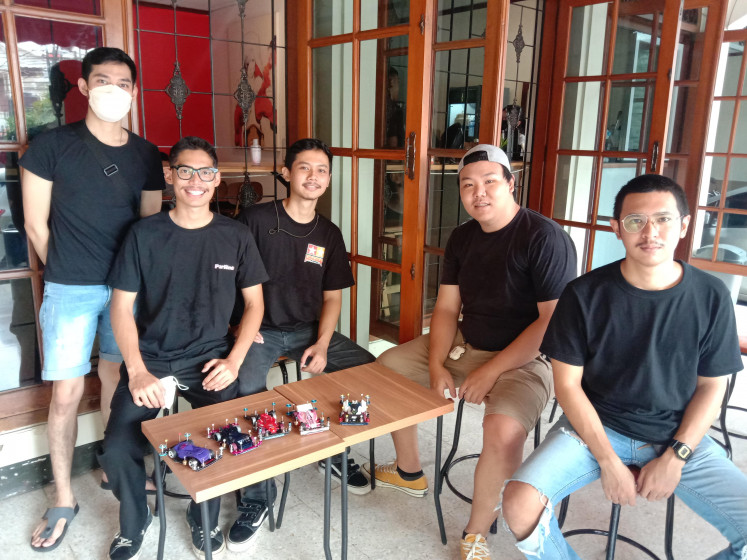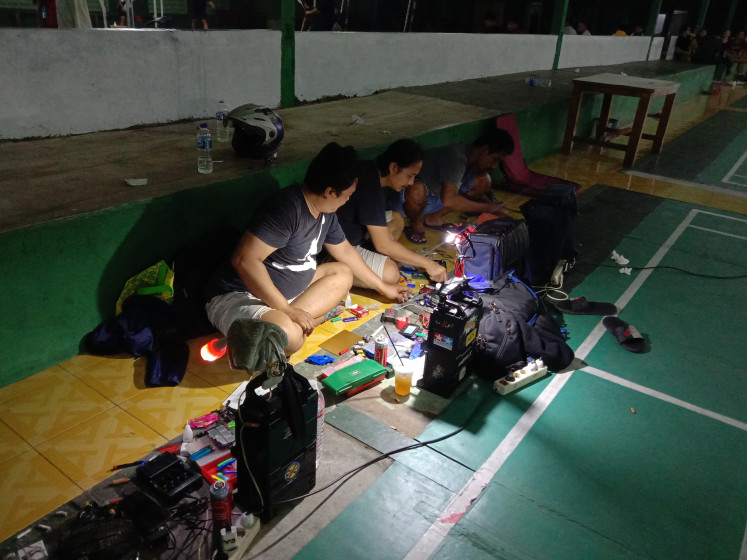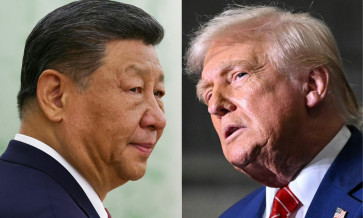Popular Reads
Top Results
Can't find what you're looking for?
View all search resultsPopular Reads
Top Results
Can't find what you're looking for?
View all search resultsLocal enthusiasts still keeping flame of '90s Tamiya racing fever
Three decades have passed since the Japanese toy manufacturer released its iconic four-wheeled drive model car, yet everyone from the current generation to adults are keeping the tracks hot.
Change text size
Gift Premium Articles
to Anyone
T
hree decades have passed since the Japanese toy manufacturer released its iconic four-wheeled drive model car, yet everyone from the current generation to adults are keeping the tracks hot.
Cars and motorcycles were parked in front of an indoor sports venue last Friday in Cijantung, East Jakarta. A loud cheer erupted when a radio-controlled car zoomed past the finish line.
"This guy's insane!" the crowd shouted and laughed.
A variety of automotive vehicles were parked on Saturday in front of a hobby shop in Blok M, South Jakarta. The following day, they were parked in the parking lot of a coffee shop in Kemang, South Jakarta.
From teens and men to several women, the owners of these vehicles had gathered for one purpose: to race their radio-controlled cars by Tamiya, a Japanese brand loved by kids the world over that dominated the local hobby car scene in the 1990s and 2000s.
Forever young
While the company also produces battery- and solar-powered cars as educational models as well as a variety of modeling tools and supplies, for most Indonesians, the name Tamiya is an eponym for the Mini 4WD (four-wheel drive) battery-powered model cars that the Japanese company launched in 1986.
The Mini 4WD hit it big in Japan in the 1990s before it took off in the United States and then to an even bigger reception in Asian countries, including Indonesia, which cemented its status as a “classic” among other treasured toys from the ‘90s.
The serial manga Dash! Yonkuro (Shogakukan, 1987-1992), which also ran a short-lived anime adaptation on TV Tokyo in 1989-1990, introduced a protagonist possessed with superhero-like skills in racing the Mini 4WD that established the model’s popularity among younger fans.
Who would have thought that the Mini 4WD’s local popularity would last for decades?
Serious tinkering: The Parlente Tamiya team’s toolbox contains some of the tools and parts it uses to modify and maintain their Mini 4WDs. (Courtesy of Radhiyya Indra) (JP/Courtesy of Radhiyya Indra)Just last year, bassist Sammy Bramantyo of rock band Seringai and vocalist Iga Massardi of alt-pop band Barasuara caught the social media spotlight over their much-hyped Tamiya race, initiating a whole new generation to the trend.
“I started to become interested in Tamiya during the PSBB [large-scale social restrictions] when I saw artists like Sammy and Iga race it. I had never actually raced Tamiya before,” said Rifqi Farhan, 23.
When Rifqi tried his hand at racing the Mini 4WD and shared his experience on Instagram, he unexpectedly learned that some of his friends also shared the same interest. Thus, the Parlente Tamiya team was formed.
“I went to the same high school as Rifqi,” Parlente Tamiya member Anandya Gibran told the Post, and when he saw that Rifqi liked the Mini 4WD, “I said, ‘Let’s just try playing, no need to join a race, just assemble some models.’”
“But when we joined our first race, we just became addicted,” Anandya said.
It seems that the trend was experiencing a revival even before the pandemic.
“I started playing with Tamiya [cars] again in 2017-2018, when I found an official Tamiya store from Japan called Graha Tamiya in front of UMN in Tangerang. I saw so many UMN students playing there,” said Reza Arista, now 27, referring to Multimedia Nusantara University in Banten.
According to Andhika “Acil” Suryosantoso, who organizes Tamiya races, the hype has lasted since it began in Indonesia in the early ‘90s.
“I have been playing since 1996, and I started to really [get into] active racing in 2002,” said the 37-year-old who has been a Tamiya racer and winning competitions in various cities for more than two decades.
Acil has basically chronicled the Tamiya trend in the country over the past 20 years, noting when it rose and ebbed.
“There was a time in 2010 when it was as good as dead. People during that year would see a Tamiya store or race and think, ‘Oh, that still exists?’” he explained.
But one thing Acil is sure about is that it never died out.
“Lately, the enthusiasm has become even more apparent,” he added.
Serious business
One of the main reasons the Mini 4WD trend had persisted, Acil said, was because new race categories or classes were constantly popping up, giving new life to the Tamiya community.
The adaptability of the races is another factor. Tamiya races can be found anywhere, from a hobby shop to a deserted corner of a shopping mall, offering a space for Tamiya enthusiasts to grow closer.
The Antaro race that Acil organized saw over 60 participants at Kopi Sakti, a small coffee shop inhabiting the corner lot of a row of shops on Jl. Kemang Timur.
“We started getting to know other people and other teams [from] our first competition in Condet,” Rifqi said, referring to a road passing a densely packed residential and commercial area in Kramat Jati, East Jakarta.
South Tangerang and South Jakarta are two Tamiya “scenes”, each with its own base camp and popular racetracks.
“There’s also one in Bandung, and it barely scratches the surface. We have communities in Makassar, Palembang, even Papua,” said Leo Hardy, owner of the Brother Tamiya store in East Jakarta.
Racing on: The Parlente Tamiya racing team, considered juniors among other Tamiya racers, pose with their Mini 4WDs at a race held on Jan. 9, 2022 in Kemang, South Jakarta. (Courtesy of Radhiyya Indra) (JP/Courtesy of Radhiyya Indra)Parlente Tamiya members admit that the hobby does not come without a price, with enthusiasts spending anywhere from Rp 100,000 (US$6.99) to more than Rp 1 million for the parts they needed to modify the cars for racing.
The races are not small events, either. Tamiya competitions are held nationally, in the Asian region, even internationally, and can offer prize money of up to Rp 90 million for each winner. Parlente Tamiya has been lucky to win a few, even as a junior team.
“It’s a profitable hobby if we win,” Rifqi said with a laugh. “But our main goal has always been to have fun above all else.”
Pit stop: A Tamiya racing team’s “engineers” tweak their Mini 4WDs before heading back to the racetrack. (Courtesy of Radhiyya Indra) (JP/Courtesy of Radhiyya Indra)Enduring love
On discovering the official Graha Tamiya store, Reza bought other ‘90s anime-inspired toys like the Beyblades spinning top and yo-yos, but he was put off by the maker’s new models.
“The old versions we had in our day are gone. They’ve become expensive collectors’ items,” said Reza.
“Strangely enough, Tamiya’s packaging hasn’t changed one bit since I was in elementary school, so it makes me [nostalgic],” he added.
While he is not a racer, Reza likes playing with Tamiya cars all day with his friends as well as watching YouTube videos of Tamiya racers.
He also met many Tamiya enthusiasts at a racing event at Jordan Toys in QBIG, South Tangerang, before the pandemic hit in 2020.
“Tamiya enthusiasts are really varied in their backgrounds. I can meet boys my age, middle-aged pilots, doctors, [it’s] a weird combination of people,” Reza noted.
“Some dads even bring their sons just to catch the Tamiya cars bouncing off the tracks,” he laughed.
Sometimes, it was the children who dragged their parents to a race as Leo demonstrated, pointing to a boy and his father fixing a Mini 4WD in one corner of the Banthong Sports Center in Kalisari, East Jakarta.
“That kid has been racing Tamiya at our store since he was in the third grade. One day, he finally brought his dad to play, too,” Leo said.
No other ‘90s toy compares with the Mini 4WD for Anandya, who used to play with Tamiya cars when he was little.
“I love collecting other ‘90s toys, but Tamiya is the only one that still exists [today], has a hype around it and a big community,” he said.
Most importantly, racing Tamiya as an adult feels like he is fulfilling his childhood dream.
“It’s like this is my time to finally play [properly], because back then I didn’t have enough money to buy [...] parts,” Anandya said.
It is likely a sentiment shared by many of his fellow Tamiya devotees.

